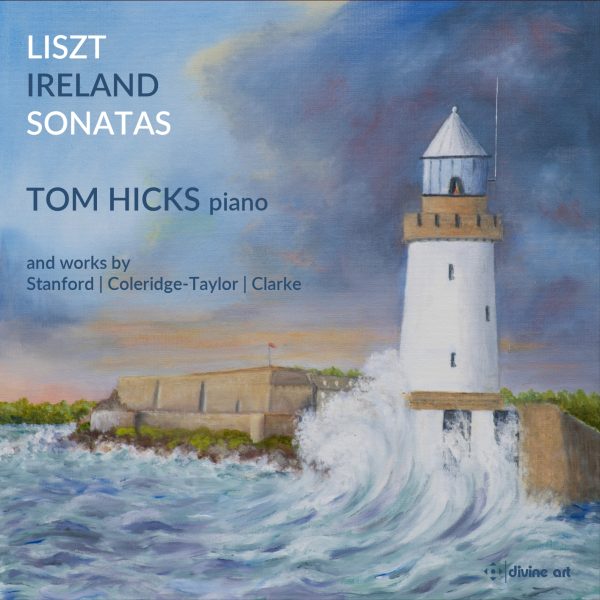Infodad
Tom Hicks’ new CD on the Divine Art label is 100% for, about and featuring the piano, in a recital that is somewhat uneven in the interest level of the pieces but certainly very varied in presentation. Liszt’s well-known and massive B minor sonata gets a broad, committed, intense performance here, with Hicks delving deeply into the somewhat overdone emotionalism of the piece and presenting its varied and contrasting sections with strength and solidity. The sonata tends to sprawl, and Hicks lets it do so, capturing the differing moods of its movements and sections-within-movements while still making clear that it is a unified whole.
The contrast with John Ireland’s sonata is a fascinating one. The two works are separated by most of a century – Liszt’s dates to 1853, Ireland’s to 1918-20. But Ireland’s seriousness and expansiveness compare very well with Liszt’s, although Liszt is more gestural in his emoting and Ireland more heartfelt (his sonata is in part a response to the Great War). Ireland’s sonata makes some of its points through a level of dissonance that Liszt never employed, and Ireland’s stately central movement is in a style all his own – one that Hicks clearly finds quite congenial. The Ireland sonata is a major work that is filled with intensity and expressiveness that Hicks brings out with considerable skill – this is a very involved and knowing performance. A bit oddly, the two sonatas appear at the conclusion of the CD, following Hicks’ playing of four short encore-like pieces. Two preludes by Charles Villiers Stanford open the disc and go by pretty much in a flash – together they last barely three minutes. Next comes an attractive, small-scale slow waltz by Samuel Coleridge-Taylor, and then a serious (but also small-scale) Cortège by Rebecca Clarke, which nicely sets up the mood of the Ireland sonata that follows it. Everything is well-played and attractive, although the mixture of music is a trifle on the odd side. The fine renditions of the major works by Liszt and Ireland are very much the primary attractions here.
@divineartrecordingsgroup
A First Inversion Company
Registered Office:
176-178 Pontefract Road, Cudworth, Barnsley S72 8BE
+44 1226 596703
Fort Worth, TX 76110
+1.682.233.4978










![Listen to the full suite of Marcel Dupré’s Variations Sur un Noël, Op. 20 from Alexander Ffinch’s #Expectations release today! listn.fm/expectations [in bio]](https://scontent-dfw5-1.cdninstagram.com/v/t51.71878-15/588904367_2327488161082898_8709236950834211856_n.jpg?stp=dst-jpg_e35_tt6&_nc_cat=105&ccb=7-5&_nc_sid=18de74&efg=eyJlZmdfdGFnIjoiQ0xJUFMuYmVzdF9pbWFnZV91cmxnZW4uQzMifQ%3D%3D&_nc_ohc=H8WFKm530VcQ7kNvwGIamXN&_nc_oc=AdkCU0bHzQ_0XTKomMoPppVnXnL1o2Frx1p2Wu6t5LBXNQzH6Wl0TsxZ8qP8dary_oI&_nc_zt=23&_nc_ht=scontent-dfw5-1.cdninstagram.com&edm=ANo9K5cEAAAA&_nc_gid=SPTFzkrIOD6SSyDEeWIBtg&oh=00_AflfQX8dJ2PQlRfOf-cE5S6uiLcUQ78cXG8yrNvtzs9pew&oe=695530EA)

![“the ‘Manteca’ Paraphrase – a rare foray into the two-piano medium but here played double-tracked – exudes a panache of which Dizzy Gillespie would surely have approved.… [a] recital well worth investigating.” —Gramophone Magazine with high praise for Ophelia Gordon's debut release, Kapustin: Between the Lines!](https://scontent-dfw5-3.cdninstagram.com/v/t51.82787-15/598796470_18303255136283342_540941604740887837_n.jpg?stp=dst-jpg_e35_tt6&_nc_cat=108&ccb=7-5&_nc_sid=18de74&efg=eyJlZmdfdGFnIjoiRkVFRC5iZXN0X2ltYWdlX3VybGdlbi5DMyJ9&_nc_ohc=IC4zZ7tcpb8Q7kNvwExli9l&_nc_oc=AdkjWertDMestob1858EBfq-ZPSKTc3bZmsrCEnRSML_lEfnhcAUU0oX3XgJxqDYQq0&_nc_zt=23&_nc_ht=scontent-dfw5-3.cdninstagram.com&edm=ANo9K5cEAAAA&_nc_gid=SPTFzkrIOD6SSyDEeWIBtg&oh=00_Afl00CtudigeRGbu5zfgTNYSWA2ZPtxXGEVnkusdBxzBWQ&oe=69550B44)